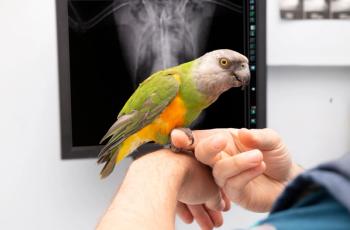
- dvm360 May 2022
- Volume 53
- Issue 5
- Pages: 42
Earlier dermatology referral rewards primary care practice (part 1): easing client expenses and enhancing patient care
A new survey from the American College of Veterinary Dermatology shows why patients with dermatologic conditions should be a higher priority for referral
Pets with dermatologic problems provide a substantial caseload in primary care veterinary practice. It’s often difficult to identify the underlying and contributing causes of dermatologic conditions, so it can be challenging to effectively and efficiently treat these patients while satisfying clients’ expectations. Such challenges may arise in part because of clients’ financial, emotional, physical, or time constraints that delay or prohibit diagnostic testing and treatment or prevent clients from completing their pets’ prescribed therapies.
New client survey data from the American College of Veterinary Dermatology (ACVD) indicates that referral to board-certified veterinary dermatologists earlier in the patient evaluation process may alleviate some of these client constraints and benefit primary care practices, their clients, and dermatology patients.
Survery purpose and design
Dermatology referrals may not be top of mind for primary care practitioners because unlike pets presented with orthopedic, neurologic, or cardiac issues that require immediate referral to a specialist, pets with dermatologic disease less frequently present with problems that seem urgent or life-threatening. In fact, veterinary dermatology has the second-lowest referral rate among several veterinary specialty groups (Figure 1).
In 2019, I partnered with the ACVD to survey clients’ perceptions of primary vs specialty veterinary care related to their dogs’ signs of dermatologic problems. Clients were recruited to participate from veterinary dermatology specialty practices in the United States (95% of participants) and Canada, and clients must have visited a primary care veterinarian for their dog’s preliminary examination and diagnosis.
Clients answered online retrospective survey questions about their dogs’ exams, diagnoses, and treatments delivered by their primary care veterinarian and by a board-certified veterinary dermatologist. The dogs presented for evaluation of a variety of dermatologic issues such as pruritus, ear problems, coat changes, and skin lesions including masses. Of the 283 clients who were included in the survey, 77% had first noted their dog’s dermatologic problem within the 2 years preceding the survey.
Recurrent patient visits
Twenty-seven percent of clients reported that their dogs were successfully treated after their first visit with the primary care veterinarian. However, these clients had visited a veterinary dermatologist because their pet’s condition had resolved and then recurred or because the condition was the first episode of a chronic problem.
Most clients (73%) reported that they visited their primary care veterinarian more than 3 times for evaluation of their pet’s dermatologic condition before they were offered a referral to a board-certified veterinary dermatologist. Of these clients, 42% had visited their primary care veterinarian an average of 5 times before referral and 31% had sought a second opinion from another primary care veterinarian.
Diagnosis disagreements
Primary care veterinarians may delay referring their patients for specialty care because they have confidence in their treatment selection and efficacy. Yet while therapeutic options for dermatologic conditions abound, having the knowledge and experience required to use them optimally is paramount. The presenting clinical signs for many skin conditions overlap substantially and complicate diagnosis, so correctly identifying a patient’s clinical signs and subtle cytologic features is needed to institute efficient and effective treatment.
Along these lines, the ACVD survey revealed that across all the dermatologic diagnoses made by primary care veterinarians, 46% did not match the veterinary dermatologists’ diagnoses. The top 3 diagnosis mismatches were food allergy, breed-associated genetic skin condition, and skin allergy (Figure 2). Incomplete or inaccurate diagnoses can contribute to the treatment failure and disease recurrence rates of dermatologic problems and result in repeat patient visits.
The good news is that across all the dermatologic diagnoses made by primary care veterinarians, 54% matched the veterinary dermatologists’ diagnoses. However, repeat patient visits may still occur if the prescribed treatments are ineffective or if clients do not use them properly. Clients reported that 16% to 28% of the treatments prescribed by their primary care veterinarians were ineffective and that 4% of the treatments prescribed by veterinary dermatologists were ineffective. These observations suggest earlier referral is beneficial because veterinary dermatologists consistently prescribe more effective treatment.
Cost and consquences of client frustration
The 73% of clients who visited their primary care veterinarian more
than 3 times for evaluation of their pets’ dermatologic problems reached a “tipping point of frustration.” This tipping point was defined as when the primary care veterinarian couldn’t control, diagnose, or resolve the pet’s dermatologic problem after 3 visits or after the client had spent $925.
Of these clients, 15% stopped visiting their primary care veterinarian for their pets’ routine veterinary care and 38% said they would not return to their primary care veterinarian for their pets’ pressing medical issues. This illustrates that primary care veterinarians risk losing future practice revenue generated by those pets (as well as revenue potentially generated by other pets in those households) by not referring clients to a veterinary dermatologist by the third visit for evaluation of patients’ dermatologic problems.
Reducing clients' costs and enhancing patient care
Referral to veterinary specialists can be considered 1 component of offering clients a spectrum of care. Spectrum of care encompasses a wide variety
of evidence-based diagnostic and treatment options—ranging from basic, lower-cost, and low-tech care options to those that are advanced, higher-cost, and state-of-the-art.1 Spectrum of care should mesh with each client’s resources, values, and goals of their pet’s care, as well as with a practice’s resources and veterinarian’s knowledge and skills.1
Primary care veterinarians may hesitate to refer patients for specialty care because they anticipate that clients will incur higher costs, or clients may decline referral because of perceived higher costs. However, the ACVD survey revealed that veterinary dermatologists addressed dogs’ issues in an average of 3.8 visits at an overall lower cost. The data showed that the 42% of clients who averaged 5 visits to their primary care veterinarian before referral to
a dermatologist would have saved 25% in costs if they had been referred by the tipping point of 3 visits. Furthermore, the 31% of clients that obtained a second opinion from another primary care veterinarian would have saved substantially more than 25% in costs.
Further discussion
In a future issue of dvm360®, part 2 of this article series will discuss the boost to client satisfaction that earlier dermatology referrals can have. In addition, it will cover the benefits to the patient of collaborative care between primary care veterinarians and specialists.
Brad Hanna is the executive vice president, director of business strategy, at Barkley, a leading marketing and insight firm in the US.
Reference
Fingland RB, Stone LR, Read EK, Moore RM. Preparing veterinary students for excellence in general practice: building confidence and competence by focusing on spectrum of care. J Am Vet Med Assoc. 2021;259(5):463-470. doi:10.2460/javma.259.5.463
Acknowledgments
The author thanks Theresa Entriken, DVM, and David Senter, DVM, DACVD, for their writing and editorial assistance with this article.
Funding
The ACVD funded this research and received no financial support for the research, authorship, and/or publication of this article.
Articles in this issue
over 3 years ago
The impact of Fear Freeover 3 years ago
The secret to happy clientsover 3 years ago
An encouraging phone call and a flopping horseover 3 years ago
Euthanasia attendants in modern practiceover 3 years ago
Lyme disease risk forecast to increaseover 3 years ago
Maximizing adherence to minimize heartworm resistanceover 3 years ago
A closer look at hydrotherapy for rehabilitationover 3 years ago
Why a blood smear evaluation should be performed with every CBCNewsletter
From exam room tips to practice management insights, get trusted veterinary news delivered straight to your inbox—subscribe to dvm360.




